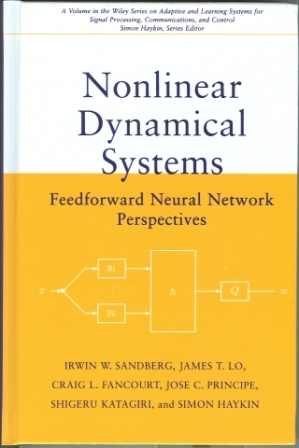 |
Nonlinear Dynamical Systems: Feedforward Neural Network Perspectives
Irwin W. Sandberg, James T. Lo, Craig L. Fancourt, Jose C. Principe, Shigeru Katagiri, and Simon Haykin
Wiley-Interscience (2001), 298 pp., Price: US $118.00
ISBN 0471349119. |
| Reviewer: Claire Postlethwaite, Dept. of Engineering Science and Applied Mathematics, Northwestern University, Evanston, Illinois, U.S. |
The field of artificial neural networks is a rapidly expanding one, and this book covers much of the theory and some applications for a particular type of neural network, those of feedforward type. Feedforward networks (FFNs) are special because information can only flow in one direction, and the nodes within the network can be ordered into "layers." Feedforward networks can "learn"
certain tasks by adapting the weights on the connecting edges and in this way have similarities to the human brain.
The book is divided into five chapters, each written by one or two of the authors. As is sometimes the case with books of this type (that is, written by several authors) the quality varies somewhat between the chapters. The consistency of notation between the chapters is sometimes questionable, which whilst a minor point, should have been easy to fix.
The first, introductory, chapter is written by Simon Haykin. Whilst it is a good introduction to the material covered in the book, it does not really act as a good introduction to the subject itself, and I found it leaping into concepts I was not familiar with. In particular, I found no good definition of a feedforward neural network to start with, and the chapter immediately moves onto learning techniques for such networks. I actually found it more useful to read this chapter again once I had read through the rest of the book. The figures in this chapter and throughout the book are useful, but I found the figures, particularly in this chapter, to not be as professional-looking as I might have expected.
The second chapter, by Irwin Sandberg, concerns classification problems. That is, for a set of inputs, we wish to map each distinct input to a distinct real number using only simple structures, such as linear maps. This chapter contains a lot of functional analysis, although it gives references for the reader who is not familiar with these concepts. The third chapter is by James Lo and discusses the use of neural networks to approximate functions. These techniques can be added to those of chapter two to show that FFNs can be used to classify signals, although I would have liked to see more links between the two chapters explaining this in more detail.
The fourth chapter is in my opinion the best written and most approachable (although also the longest) of the book. It discusses the problem of classifying piecewise-stationary data by various algorithms implemented by FFNs. The authors, Craig Fancourt and Jose Principe, first give a good introduction to all the concepts used in the chapter, such as the concept of stationarity in random and chaotic data, ergodicity, etc. The chapter focuses around two sets of (piecewise-stationary) data they have created and then uses them to test a number of classification algorithms. Each algorithm is clearly explained and the results of the classification tests are well displayed.
The final chapter of the book, by Shigeru Katagiri, discusses the application of FFNs to speech recognition. I enjoyed the cartoon-like diagrams in this chapter, but I felt more discussion and annotation of the more technical diagrams was needed.
Overall, this is an interesting book, useful for researchers in network theory who are looking for detailed information on feedforward networks in particular. However, much background knowledge is assumed, both in network theory and analysis, so it would not be so useful as an introductory text to the subject.
|